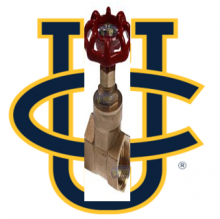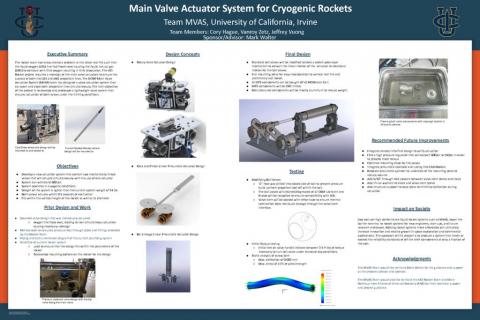UCI Rocket Project - Main Valve Actuation System
Background
At UCI Rocket Project's most recent engine test fire, they experienced an anomaly in which their main oxidizer valve did not open, resulting in methane simply combusting with the air in the chamber and producing very little thrust. In order to avoid this in future tests, the project is investigating different methods of fixing this hardware issue. While the main project members explore ways of doing this with existing hardware, the Main Valve Actuation System (MVAS) team will develop a method of doing this with commercial off-the-shelf hardware.
What is very important in our design is that we have a mechanical linkage between two valves that will be open and close by one actuator. Most designs such as the current solenoid valve design of the UCI rocket project utilizes two actuators for each of their solenoid valves. To accomplish this, the use of motors and a pinion gear mechanism to simultaneously actuate each of the valves when needed.
For a rocket to create propulsion, it is pivotal that an oxidizer, in this case, liquid oxygen, is combusted in a chamber with a fuel which in this case is liquid natural gas. Rockets contain a multitude of fluids such as liquid oxygen, liquid natural gas, nitrogen and liquid hydrogen. In order to distribute these fluids to where they are needed, a plumbing system is required. When designing a plumbing system to distribute the fluids, consideration for bends and turns of the system is essential because of the head losses.
To be able to control the fluid the use of valves and actuators will be implemented. An actuator is used such that a valve can be opened automatically from a far location. There are various kinds of actuators and valves that are used for fluid release. Different kinds of valves include ball valves, butterfly valves, globe valves, gate valves, and solenoid valves.
A ball valve is a mechanical valve that controls the flow of fluid using a ball that is attached to a handle. Turning the handle allows for flow to either enter or stop through the valve.
Goal and Objectives
- The two valves must be able to open and close reliably under cryogenic Liquid Oxygen (LOX) and Liquefied Natural Gas (LNG) operating conditions
- A single actuator must be able to open and close the two valves at the same time
- Must be compatible with existing electronics and control system
- Needs a mechanical linkage that will link the two valves in order to translate actuator motion to opening and closing of the valves
Project Timeline
Week 5: Decide on final design of actuation system. This includes final valve selection, actuator selection, and linkage design. Present preliminary design review to UCI Rocket Project and project advisor.
Week 6: Develop CAD models of hardware and circuit diagrams for verifying compatibility with existing electronics. Start doing preliminary analyses of final design. This includes thermal analysis, stress analysis, and motion study.
Week 7: Present critical design review to UCI Rocket Project and project advisor. Verify that final design meets all specifications and requirements.
Week 8: Start ordering part to begin manufacturing process. Present final design review to UCI Rocket Project and project sponsor. Validate the logistics of the design.
Week 9: Start building component. Test component with liquid nitrogen to ensure reliability under cryogenic operation.
Week 10: Turn validated design over to UCI Rocket Project. Complete other necessary documentation to close out the project.
Website Link
To learn more about the UCI Rocket Project, visit their team website: https://rocket.eng.uci.edu/
Team Contacts
Cory Hague chague@uci.edu
Jeffrey Vuong jeffrecv@uci.edu
Vanroy Zetz vzetz@uci.edu
Sponsor/Advisor
Mark Walter m.walter@uci.edu


